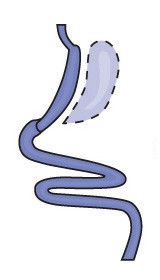What is weight loss surgery?
Weight loss surgery, also known as bariatric or metabolic surgery, is a tool for losing a large amount of weight. It limits the amount of food you can eat and changes how your body absorbs nutrients. We may recommend weight loss surgery when you are severely overweight or when obesity affects your health.
However, weight loss surgery is a tool to help you lose a lot of weight — it is not a cure for obesity. You must maintain a healthy lifestyle of active living and mindful eating after surgery, or you can regain the weight. You can find more about how to do this in the What to Expect section.
It is critical that you commit to the recommended lifestyle changes, such as eating a certain number of calories, taking daily vitamins and minerals, and exercising regularly before you have weight loss surgery.
How weight loss surgery works

Once we chew food and swallow, it travels down the esophagus and into the stomach, which can hold a large amount of food.
Digestive fluids in the stomach turn solid foods into liquid. The liquid then travels from the stomach into the small intestine.
The small intestine absorbs nutrients and calories, while waste products travel through the large intestine.
Weight loss surgery works by:
- Restricting the amount of food you can eat by making your stomach smaller.
- Decreasing absorption by making a new path to the intestine (called bypass) to limit the amount of calories absorbed.
- Decreasing hunger by reducing the amount of hunger hormone (called ghrelin) your stomach makes.
You may only feel less hungry due to reduced hormonal effects for a few years after having weight loss surgery. To maintain lifelong weight loss success, you must break bad habits that cause obesity, continue to make healthy food choices, and exercise regularly.
Surgery Types
The type of weight loss surgery we recommend depends on your current health and the amount of weight you need to lose.Together we will talk about the benefits, risks, and identify the type of surgery right that is right for you.
While weight loss surgery is generally considered safe, there are risks associated with any surgery, such as excessive bleeding, infection, and blood clots.
Roux-en-Y Gastric Bypass
What it is
Roux-en-Y Gastric Bypass reduces the size of your stomach and bypasses some of the intestine.
How it works
This surgery restricts the amount of food that you can eat and prevents food from being absorbed in the first portion of your small intestine. It also triggers hormonal changes that stop you from feeling hungry.
Roux-en-Y Gastric Bypass results
Within the first year after having gastric bypass, you may lose 50 percent to 80 percent of your extra body weight, which may be about 30 percent to 50 percent of your total current weight. You may maintain this weight loss for up to 10 years or longer, if you follow healthy lifestyle guidelines.

Watch our Gastric Bypass program (Emmi). For Kaiser Permanente members only.
Sleeve Gastrectomy
What it is
Sleeve gastrectomy (or SG), also called Laparoscopic Sleeve Gastrectomy (or LSG) removes about 80 percent of your stomach, but does not involve bypassing the small intestine.
How it works
Because your stomach is smaller, you feel full after eating a small amount of food. Ghrelin, the appetite-stimulating hormone, is also reduced, so you generally feel less hungry, especially in the months and years right after surgery.
Sleeve Gastrectomy results
Within the first year after having sleeve gastrectomy, you may lose 50 percent to 80 percent of your excess body weight. You may maintain this weight loss for up to 10 years or longer, if you follow healthy lifestyle guidelines.

Watch our Sleeve Gastrectomy program (Emmi). For Kaiser Permanente members only.
Which surgery is right for you?
The gastric bypass has been performed since the 1970’s and became popular in the United States by 2000. It is considered the ‘gold standard’ operation for weight loss.
The sleeve gastrectomy has become increasingly popular since 2010, largely because the risks of re-operation and complications may be less than with the gastric bypass. However, the long-term weight loss may be less than with the gastric bypass, and the long-term effects are still unknown.
The lap band was very popular from 2000 to 2010, but currently, very few bariatric surgeons recommend this procedure because the failure and removal rate is very high.
Choosing the right operation can depend on many factors, and we partner with you to help choose the most appropriate operation for you and any specific conditions you may have.
Surgery techniques
Once it’s decided which weight loss surgery you will have, there are two kinds of surgical techniques we may use to perform the surgery. There is no difference in weight loss results between the two. The two techniques are:
Laparoscopy
This is the typical surgical procedure for weight loss surgery. We make 5 to 6 small cuts in your abdomen and place long, thin instruments and a tiny camera through the small cuts to perform surgery. Laparoscopic procedures can be limited by high body mass index (BMI), the size of the liver, the anatomy within the abdomen, or the technical limits of the instruments and equipment.
Open surgery
A less common surgery, this procedure means we make a single, longer cut in your upper abdomen to access your stomach and other areas. Open surgeries usually are performed if you have had prior abdominal operations, large abdominal wall hernias, cardiac disease, or a high body mass index (BMI), as these conditions may make laparoscopic surgery challenging or excessively long, increasing the risk of complications.
